Different Business Structures in Australia: A Legal Advice
VerifiedAdded on 2023/06/11
|12
|3327
|109
AI Summary
This article provides legal advice on different business structures in Australia including sole trader, partnership, trust, joint venture and company. It explains the legal requirements and characteristics of each structure. The article also discusses the statutory duties of directors in a corporation and the importance of such duties in relation to the governance of the company.
Contribute Materials
Your contribution can guide someone’s learning journey. Share your
documents today.

Commercial Law
Secure Best Marks with AI Grader
Need help grading? Try our AI Grader for instant feedback on your assignments.
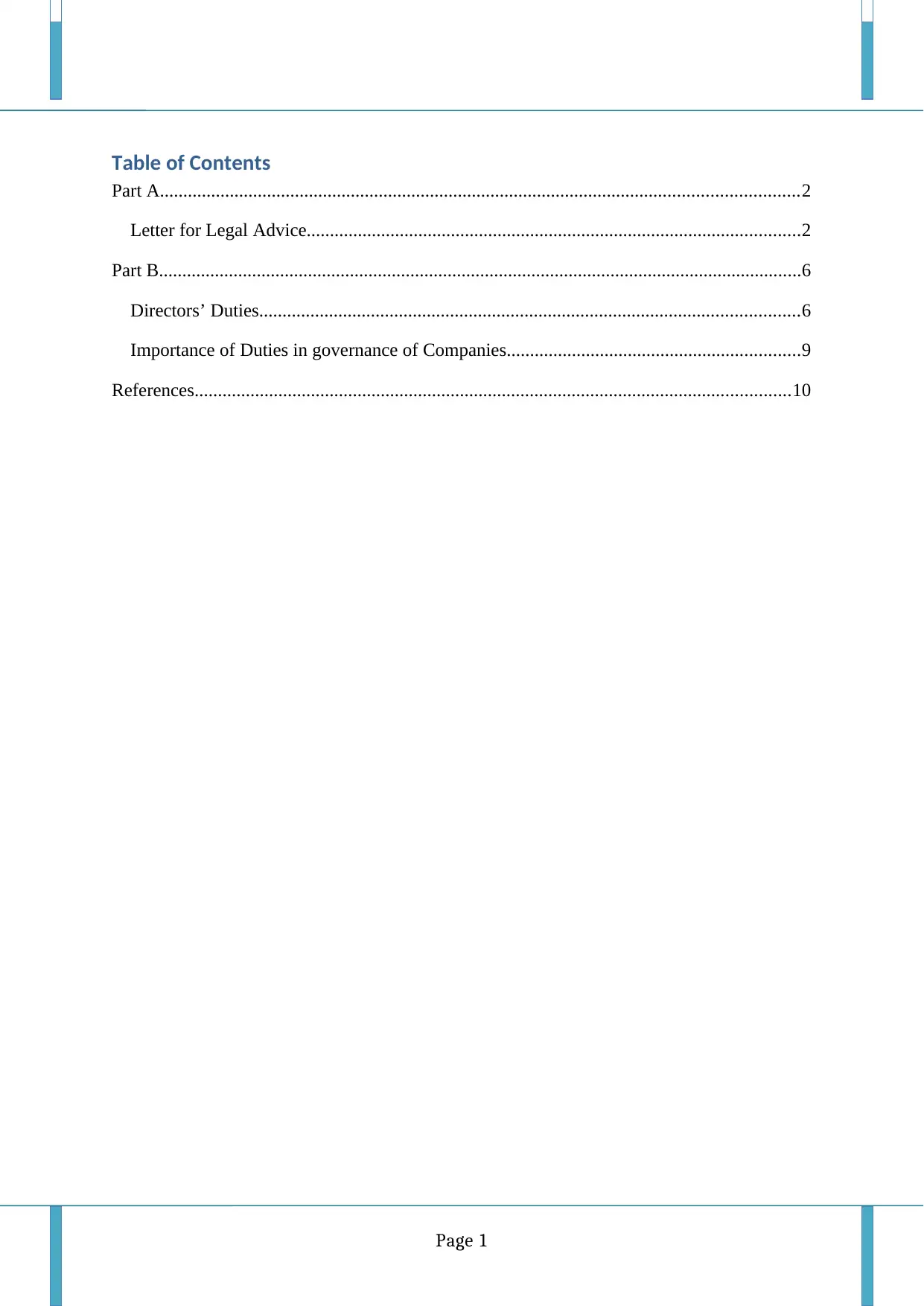
Table of Contents
Part A.........................................................................................................................................2
Letter for Legal Advice..........................................................................................................2
Part B..........................................................................................................................................6
Directors’ Duties....................................................................................................................6
Importance of Duties in governance of Companies...............................................................9
References................................................................................................................................10
Page 1
Part A.........................................................................................................................................2
Letter for Legal Advice..........................................................................................................2
Part B..........................................................................................................................................6
Directors’ Duties....................................................................................................................6
Importance of Duties in governance of Companies...............................................................9
References................................................................................................................................10
Page 1
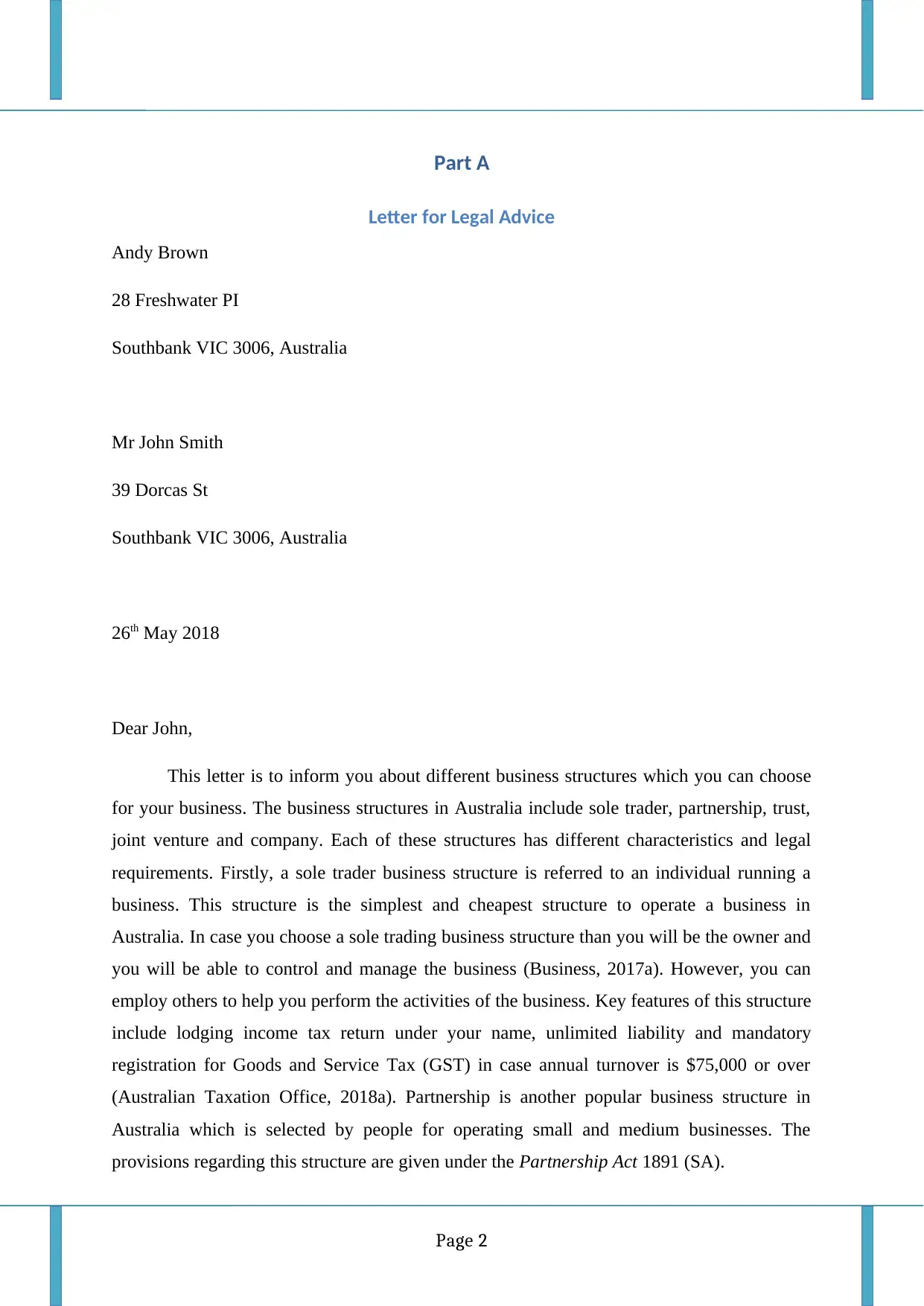
Part A
Letter for Legal Advice
Andy Brown
28 Freshwater PI
Southbank VIC 3006, Australia
Mr John Smith
39 Dorcas St
Southbank VIC 3006, Australia
26th May 2018
Dear John,
This letter is to inform you about different business structures which you can choose
for your business. The business structures in Australia include sole trader, partnership, trust,
joint venture and company. Each of these structures has different characteristics and legal
requirements. Firstly, a sole trader business structure is referred to an individual running a
business. This structure is the simplest and cheapest structure to operate a business in
Australia. In case you choose a sole trading business structure than you will be the owner and
you will be able to control and manage the business (Business, 2017a). However, you can
employ others to help you perform the activities of the business. Key features of this structure
include lodging income tax return under your name, unlimited liability and mandatory
registration for Goods and Service Tax (GST) in case annual turnover is $75,000 or over
(Australian Taxation Office, 2018a). Partnership is another popular business structure in
Australia which is selected by people for operating small and medium businesses. The
provisions regarding this structure are given under the Partnership Act 1891 (SA).
Page 2
Letter for Legal Advice
Andy Brown
28 Freshwater PI
Southbank VIC 3006, Australia
Mr John Smith
39 Dorcas St
Southbank VIC 3006, Australia
26th May 2018
Dear John,
This letter is to inform you about different business structures which you can choose
for your business. The business structures in Australia include sole trader, partnership, trust,
joint venture and company. Each of these structures has different characteristics and legal
requirements. Firstly, a sole trader business structure is referred to an individual running a
business. This structure is the simplest and cheapest structure to operate a business in
Australia. In case you choose a sole trading business structure than you will be the owner and
you will be able to control and manage the business (Business, 2017a). However, you can
employ others to help you perform the activities of the business. Key features of this structure
include lodging income tax return under your name, unlimited liability and mandatory
registration for Goods and Service Tax (GST) in case annual turnover is $75,000 or over
(Australian Taxation Office, 2018a). Partnership is another popular business structure in
Australia which is selected by people for operating small and medium businesses. The
provisions regarding this structure are given under the Partnership Act 1891 (SA).
Page 2
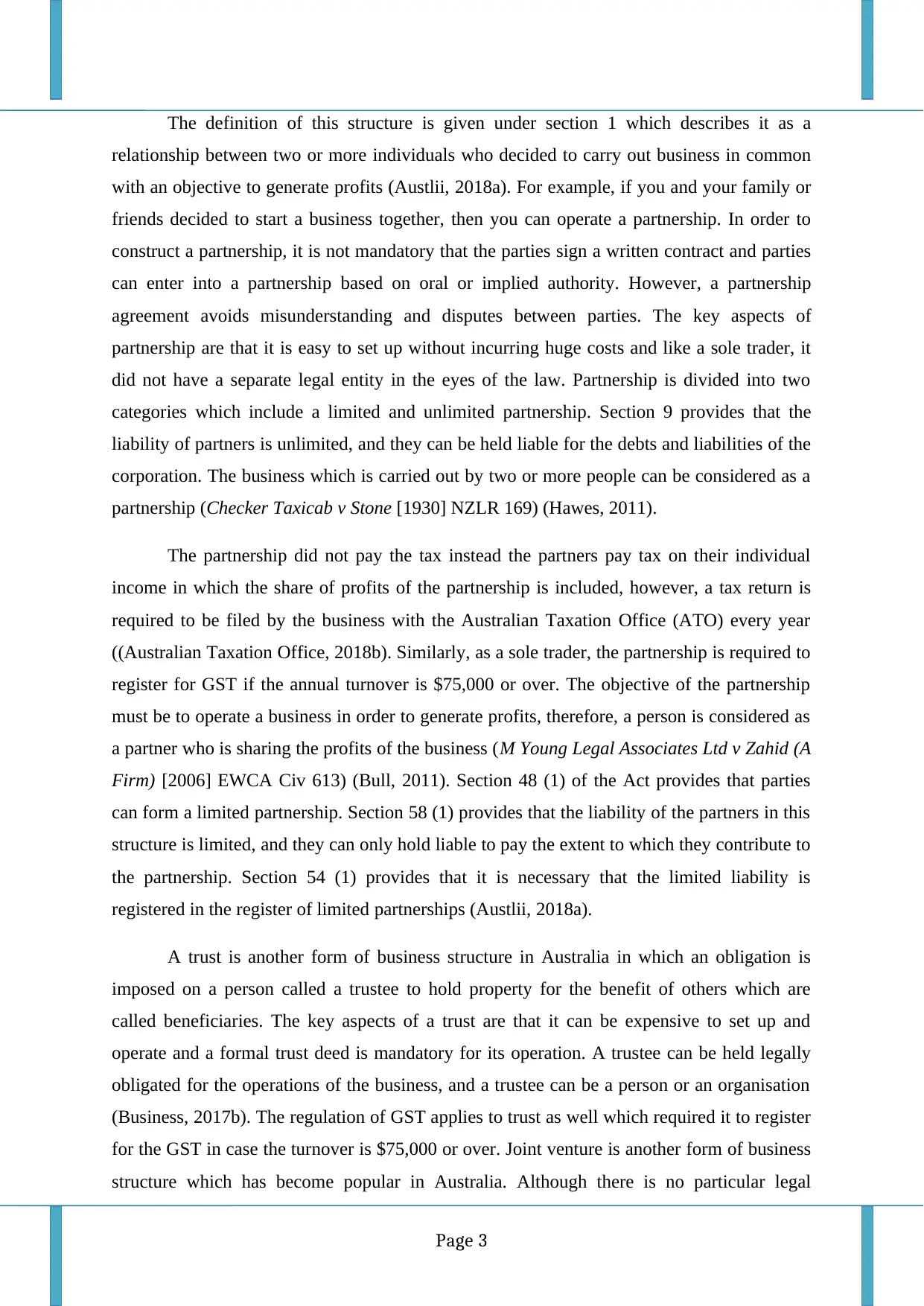
The definition of this structure is given under section 1 which describes it as a
relationship between two or more individuals who decided to carry out business in common
with an objective to generate profits (Austlii, 2018a). For example, if you and your family or
friends decided to start a business together, then you can operate a partnership. In order to
construct a partnership, it is not mandatory that the parties sign a written contract and parties
can enter into a partnership based on oral or implied authority. However, a partnership
agreement avoids misunderstanding and disputes between parties. The key aspects of
partnership are that it is easy to set up without incurring huge costs and like a sole trader, it
did not have a separate legal entity in the eyes of the law. Partnership is divided into two
categories which include a limited and unlimited partnership. Section 9 provides that the
liability of partners is unlimited, and they can be held liable for the debts and liabilities of the
corporation. The business which is carried out by two or more people can be considered as a
partnership (Checker Taxicab v Stone [1930] NZLR 169) (Hawes, 2011).
The partnership did not pay the tax instead the partners pay tax on their individual
income in which the share of profits of the partnership is included, however, a tax return is
required to be filed by the business with the Australian Taxation Office (ATO) every year
((Australian Taxation Office, 2018b). Similarly, as a sole trader, the partnership is required to
register for GST if the annual turnover is $75,000 or over. The objective of the partnership
must be to operate a business in order to generate profits, therefore, a person is considered as
a partner who is sharing the profits of the business (M Young Legal Associates Ltd v Zahid (A
Firm) [2006] EWCA Civ 613) (Bull, 2011). Section 48 (1) of the Act provides that parties
can form a limited partnership. Section 58 (1) provides that the liability of the partners in this
structure is limited, and they can only hold liable to pay the extent to which they contribute to
the partnership. Section 54 (1) provides that it is necessary that the limited liability is
registered in the register of limited partnerships (Austlii, 2018a).
A trust is another form of business structure in Australia in which an obligation is
imposed on a person called a trustee to hold property for the benefit of others which are
called beneficiaries. The key aspects of a trust are that it can be expensive to set up and
operate and a formal trust deed is mandatory for its operation. A trustee can be held legally
obligated for the operations of the business, and a trustee can be a person or an organisation
(Business, 2017b). The regulation of GST applies to trust as well which required it to register
for the GST in case the turnover is $75,000 or over. Joint venture is another form of business
structure which has become popular in Australia. Although there is no particular legal
Page 3
relationship between two or more individuals who decided to carry out business in common
with an objective to generate profits (Austlii, 2018a). For example, if you and your family or
friends decided to start a business together, then you can operate a partnership. In order to
construct a partnership, it is not mandatory that the parties sign a written contract and parties
can enter into a partnership based on oral or implied authority. However, a partnership
agreement avoids misunderstanding and disputes between parties. The key aspects of
partnership are that it is easy to set up without incurring huge costs and like a sole trader, it
did not have a separate legal entity in the eyes of the law. Partnership is divided into two
categories which include a limited and unlimited partnership. Section 9 provides that the
liability of partners is unlimited, and they can be held liable for the debts and liabilities of the
corporation. The business which is carried out by two or more people can be considered as a
partnership (Checker Taxicab v Stone [1930] NZLR 169) (Hawes, 2011).
The partnership did not pay the tax instead the partners pay tax on their individual
income in which the share of profits of the partnership is included, however, a tax return is
required to be filed by the business with the Australian Taxation Office (ATO) every year
((Australian Taxation Office, 2018b). Similarly, as a sole trader, the partnership is required to
register for GST if the annual turnover is $75,000 or over. The objective of the partnership
must be to operate a business in order to generate profits, therefore, a person is considered as
a partner who is sharing the profits of the business (M Young Legal Associates Ltd v Zahid (A
Firm) [2006] EWCA Civ 613) (Bull, 2011). Section 48 (1) of the Act provides that parties
can form a limited partnership. Section 58 (1) provides that the liability of the partners in this
structure is limited, and they can only hold liable to pay the extent to which they contribute to
the partnership. Section 54 (1) provides that it is necessary that the limited liability is
registered in the register of limited partnerships (Austlii, 2018a).
A trust is another form of business structure in Australia in which an obligation is
imposed on a person called a trustee to hold property for the benefit of others which are
called beneficiaries. The key aspects of a trust are that it can be expensive to set up and
operate and a formal trust deed is mandatory for its operation. A trustee can be held legally
obligated for the operations of the business, and a trustee can be a person or an organisation
(Business, 2017b). The regulation of GST applies to trust as well which required it to register
for the GST in case the turnover is $75,000 or over. Joint venture is another form of business
structure which has become popular in Australia. Although there is no particular legal
Page 3
Secure Best Marks with AI Grader
Need help grading? Try our AI Grader for instant feedback on your assignments.
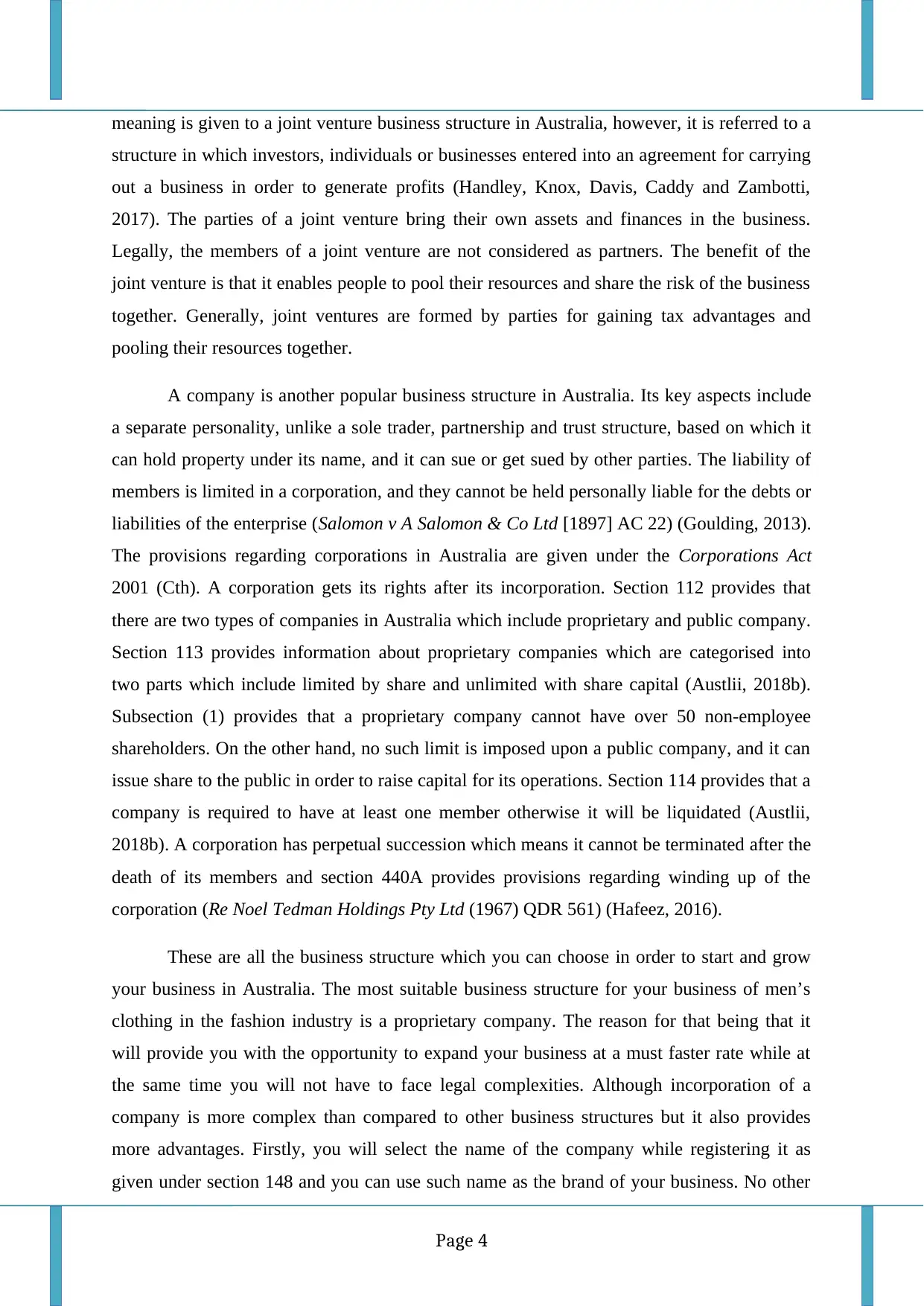
meaning is given to a joint venture business structure in Australia, however, it is referred to a
structure in which investors, individuals or businesses entered into an agreement for carrying
out a business in order to generate profits (Handley, Knox, Davis, Caddy and Zambotti,
2017). The parties of a joint venture bring their own assets and finances in the business.
Legally, the members of a joint venture are not considered as partners. The benefit of the
joint venture is that it enables people to pool their resources and share the risk of the business
together. Generally, joint ventures are formed by parties for gaining tax advantages and
pooling their resources together.
A company is another popular business structure in Australia. Its key aspects include
a separate personality, unlike a sole trader, partnership and trust structure, based on which it
can hold property under its name, and it can sue or get sued by other parties. The liability of
members is limited in a corporation, and they cannot be held personally liable for the debts or
liabilities of the enterprise (Salomon v A Salomon & Co Ltd [1897] AC 22) (Goulding, 2013).
The provisions regarding corporations in Australia are given under the Corporations Act
2001 (Cth). A corporation gets its rights after its incorporation. Section 112 provides that
there are two types of companies in Australia which include proprietary and public company.
Section 113 provides information about proprietary companies which are categorised into
two parts which include limited by share and unlimited with share capital (Austlii, 2018b).
Subsection (1) provides that a proprietary company cannot have over 50 non-employee
shareholders. On the other hand, no such limit is imposed upon a public company, and it can
issue share to the public in order to raise capital for its operations. Section 114 provides that a
company is required to have at least one member otherwise it will be liquidated (Austlii,
2018b). A corporation has perpetual succession which means it cannot be terminated after the
death of its members and section 440A provides provisions regarding winding up of the
corporation (Re Noel Tedman Holdings Pty Ltd (1967) QDR 561) (Hafeez, 2016).
These are all the business structure which you can choose in order to start and grow
your business in Australia. The most suitable business structure for your business of men’s
clothing in the fashion industry is a proprietary company. The reason for that being that it
will provide you with the opportunity to expand your business at a must faster rate while at
the same time you will not have to face legal complexities. Although incorporation of a
company is more complex than compared to other business structures but it also provides
more advantages. Firstly, you will select the name of the company while registering it as
given under section 148 and you can use such name as the brand of your business. No other
Page 4
structure in which investors, individuals or businesses entered into an agreement for carrying
out a business in order to generate profits (Handley, Knox, Davis, Caddy and Zambotti,
2017). The parties of a joint venture bring their own assets and finances in the business.
Legally, the members of a joint venture are not considered as partners. The benefit of the
joint venture is that it enables people to pool their resources and share the risk of the business
together. Generally, joint ventures are formed by parties for gaining tax advantages and
pooling their resources together.
A company is another popular business structure in Australia. Its key aspects include
a separate personality, unlike a sole trader, partnership and trust structure, based on which it
can hold property under its name, and it can sue or get sued by other parties. The liability of
members is limited in a corporation, and they cannot be held personally liable for the debts or
liabilities of the enterprise (Salomon v A Salomon & Co Ltd [1897] AC 22) (Goulding, 2013).
The provisions regarding corporations in Australia are given under the Corporations Act
2001 (Cth). A corporation gets its rights after its incorporation. Section 112 provides that
there are two types of companies in Australia which include proprietary and public company.
Section 113 provides information about proprietary companies which are categorised into
two parts which include limited by share and unlimited with share capital (Austlii, 2018b).
Subsection (1) provides that a proprietary company cannot have over 50 non-employee
shareholders. On the other hand, no such limit is imposed upon a public company, and it can
issue share to the public in order to raise capital for its operations. Section 114 provides that a
company is required to have at least one member otherwise it will be liquidated (Austlii,
2018b). A corporation has perpetual succession which means it cannot be terminated after the
death of its members and section 440A provides provisions regarding winding up of the
corporation (Re Noel Tedman Holdings Pty Ltd (1967) QDR 561) (Hafeez, 2016).
These are all the business structure which you can choose in order to start and grow
your business in Australia. The most suitable business structure for your business of men’s
clothing in the fashion industry is a proprietary company. The reason for that being that it
will provide you with the opportunity to expand your business at a must faster rate while at
the same time you will not have to face legal complexities. Although incorporation of a
company is more complex than compared to other business structures but it also provides
more advantages. Firstly, you will select the name of the company while registering it as
given under section 148 and you can use such name as the brand of your business. No other
Page 4
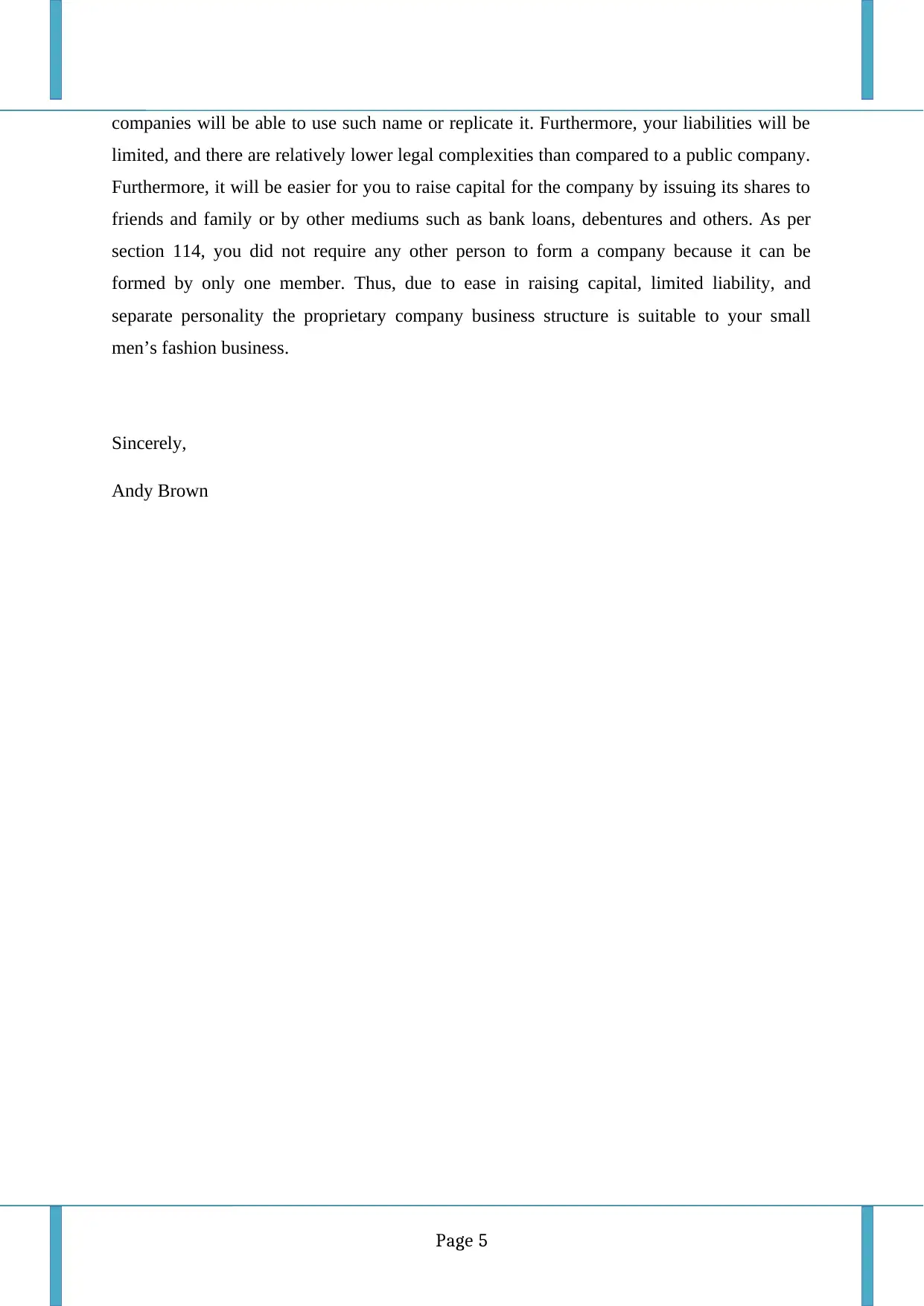
companies will be able to use such name or replicate it. Furthermore, your liabilities will be
limited, and there are relatively lower legal complexities than compared to a public company.
Furthermore, it will be easier for you to raise capital for the company by issuing its shares to
friends and family or by other mediums such as bank loans, debentures and others. As per
section 114, you did not require any other person to form a company because it can be
formed by only one member. Thus, due to ease in raising capital, limited liability, and
separate personality the proprietary company business structure is suitable to your small
men’s fashion business.
Sincerely,
Andy Brown
Page 5
limited, and there are relatively lower legal complexities than compared to a public company.
Furthermore, it will be easier for you to raise capital for the company by issuing its shares to
friends and family or by other mediums such as bank loans, debentures and others. As per
section 114, you did not require any other person to form a company because it can be
formed by only one member. Thus, due to ease in raising capital, limited liability, and
separate personality the proprietary company business structure is suitable to your small
men’s fashion business.
Sincerely,
Andy Brown
Page 5
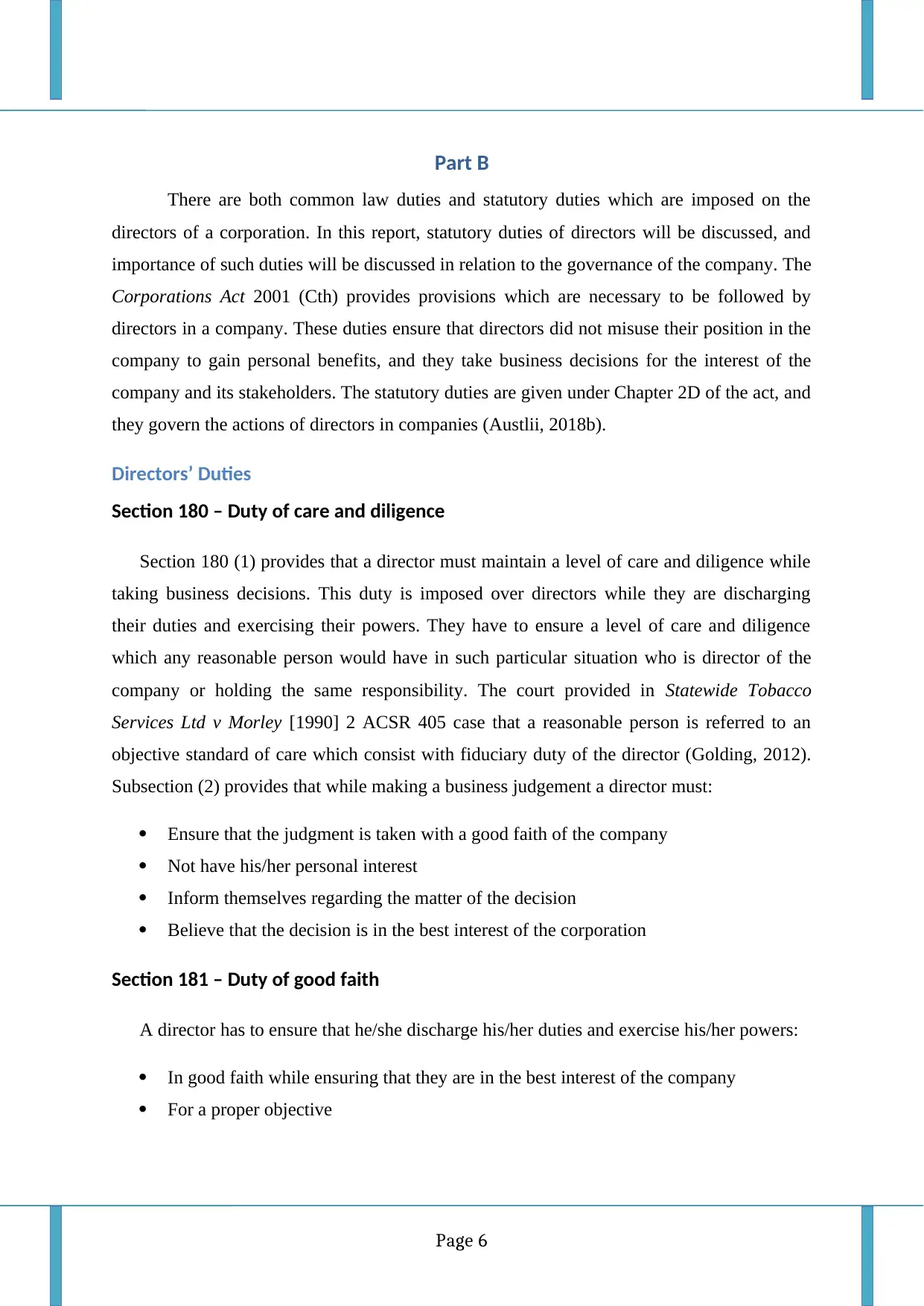
Part B
There are both common law duties and statutory duties which are imposed on the
directors of a corporation. In this report, statutory duties of directors will be discussed, and
importance of such duties will be discussed in relation to the governance of the company. The
Corporations Act 2001 (Cth) provides provisions which are necessary to be followed by
directors in a company. These duties ensure that directors did not misuse their position in the
company to gain personal benefits, and they take business decisions for the interest of the
company and its stakeholders. The statutory duties are given under Chapter 2D of the act, and
they govern the actions of directors in companies (Austlii, 2018b).
Directors’ Duties
Section 180 – Duty of care and diligence
Section 180 (1) provides that a director must maintain a level of care and diligence while
taking business decisions. This duty is imposed over directors while they are discharging
their duties and exercising their powers. They have to ensure a level of care and diligence
which any reasonable person would have in such particular situation who is director of the
company or holding the same responsibility. The court provided in Statewide Tobacco
Services Ltd v Morley [1990] 2 ACSR 405 case that a reasonable person is referred to an
objective standard of care which consist with fiduciary duty of the director (Golding, 2012).
Subsection (2) provides that while making a business judgement a director must:
Ensure that the judgment is taken with a good faith of the company
Not have his/her personal interest
Inform themselves regarding the matter of the decision
Believe that the decision is in the best interest of the corporation
Section 181 – Duty of good faith
A director has to ensure that he/she discharge his/her duties and exercise his/her powers:
In good faith while ensuring that they are in the best interest of the company
For a proper objective
Page 6
There are both common law duties and statutory duties which are imposed on the
directors of a corporation. In this report, statutory duties of directors will be discussed, and
importance of such duties will be discussed in relation to the governance of the company. The
Corporations Act 2001 (Cth) provides provisions which are necessary to be followed by
directors in a company. These duties ensure that directors did not misuse their position in the
company to gain personal benefits, and they take business decisions for the interest of the
company and its stakeholders. The statutory duties are given under Chapter 2D of the act, and
they govern the actions of directors in companies (Austlii, 2018b).
Directors’ Duties
Section 180 – Duty of care and diligence
Section 180 (1) provides that a director must maintain a level of care and diligence while
taking business decisions. This duty is imposed over directors while they are discharging
their duties and exercising their powers. They have to ensure a level of care and diligence
which any reasonable person would have in such particular situation who is director of the
company or holding the same responsibility. The court provided in Statewide Tobacco
Services Ltd v Morley [1990] 2 ACSR 405 case that a reasonable person is referred to an
objective standard of care which consist with fiduciary duty of the director (Golding, 2012).
Subsection (2) provides that while making a business judgement a director must:
Ensure that the judgment is taken with a good faith of the company
Not have his/her personal interest
Inform themselves regarding the matter of the decision
Believe that the decision is in the best interest of the corporation
Section 181 – Duty of good faith
A director has to ensure that he/she discharge his/her duties and exercise his/her powers:
In good faith while ensuring that they are in the best interest of the company
For a proper objective
Page 6
Paraphrase This Document
Need a fresh take? Get an instant paraphrase of this document with our AI Paraphraser
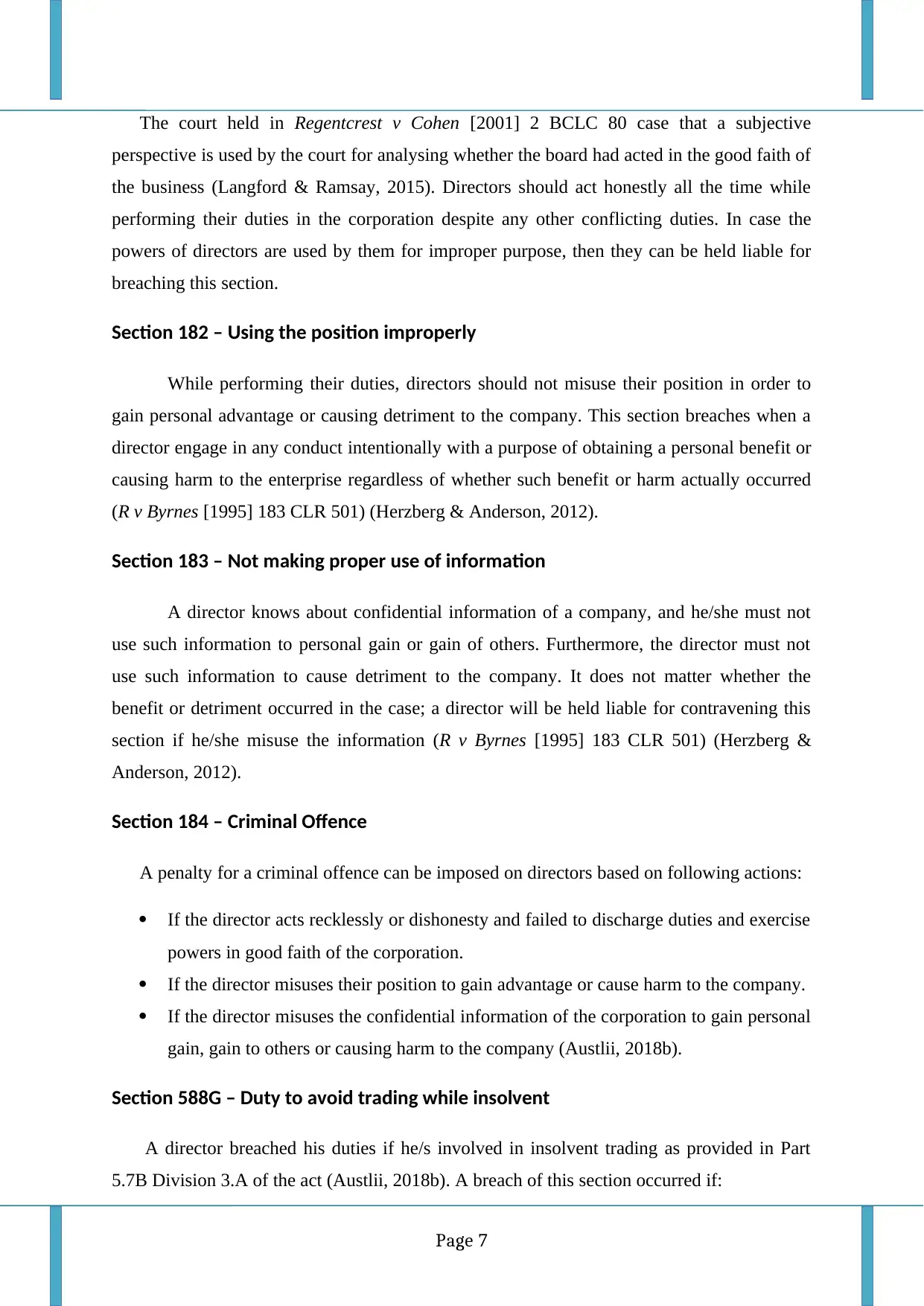
The court held in Regentcrest v Cohen [2001] 2 BCLC 80 case that a subjective
perspective is used by the court for analysing whether the board had acted in the good faith of
the business (Langford & Ramsay, 2015). Directors should act honestly all the time while
performing their duties in the corporation despite any other conflicting duties. In case the
powers of directors are used by them for improper purpose, then they can be held liable for
breaching this section.
Section 182 – Using the position improperly
While performing their duties, directors should not misuse their position in order to
gain personal advantage or causing detriment to the company. This section breaches when a
director engage in any conduct intentionally with a purpose of obtaining a personal benefit or
causing harm to the enterprise regardless of whether such benefit or harm actually occurred
(R v Byrnes [1995] 183 CLR 501) (Herzberg & Anderson, 2012).
Section 183 – Not making proper use of information
A director knows about confidential information of a company, and he/she must not
use such information to personal gain or gain of others. Furthermore, the director must not
use such information to cause detriment to the company. It does not matter whether the
benefit or detriment occurred in the case; a director will be held liable for contravening this
section if he/she misuse the information (R v Byrnes [1995] 183 CLR 501) (Herzberg &
Anderson, 2012).
Section 184 – Criminal Offence
A penalty for a criminal offence can be imposed on directors based on following actions:
If the director acts recklessly or dishonesty and failed to discharge duties and exercise
powers in good faith of the corporation.
If the director misuses their position to gain advantage or cause harm to the company.
If the director misuses the confidential information of the corporation to gain personal
gain, gain to others or causing harm to the company (Austlii, 2018b).
Section 588G – Duty to avoid trading while insolvent
A director breached his duties if he/s involved in insolvent trading as provided in Part
5.7B Division 3.A of the act (Austlii, 2018b). A breach of this section occurred if:
Page 7
perspective is used by the court for analysing whether the board had acted in the good faith of
the business (Langford & Ramsay, 2015). Directors should act honestly all the time while
performing their duties in the corporation despite any other conflicting duties. In case the
powers of directors are used by them for improper purpose, then they can be held liable for
breaching this section.
Section 182 – Using the position improperly
While performing their duties, directors should not misuse their position in order to
gain personal advantage or causing detriment to the company. This section breaches when a
director engage in any conduct intentionally with a purpose of obtaining a personal benefit or
causing harm to the enterprise regardless of whether such benefit or harm actually occurred
(R v Byrnes [1995] 183 CLR 501) (Herzberg & Anderson, 2012).
Section 183 – Not making proper use of information
A director knows about confidential information of a company, and he/she must not
use such information to personal gain or gain of others. Furthermore, the director must not
use such information to cause detriment to the company. It does not matter whether the
benefit or detriment occurred in the case; a director will be held liable for contravening this
section if he/she misuse the information (R v Byrnes [1995] 183 CLR 501) (Herzberg &
Anderson, 2012).
Section 184 – Criminal Offence
A penalty for a criminal offence can be imposed on directors based on following actions:
If the director acts recklessly or dishonesty and failed to discharge duties and exercise
powers in good faith of the corporation.
If the director misuses their position to gain advantage or cause harm to the company.
If the director misuses the confidential information of the corporation to gain personal
gain, gain to others or causing harm to the company (Austlii, 2018b).
Section 588G – Duty to avoid trading while insolvent
A director breached his duties if he/s involved in insolvent trading as provided in Part
5.7B Division 3.A of the act (Austlii, 2018b). A breach of this section occurred if:
Page 7
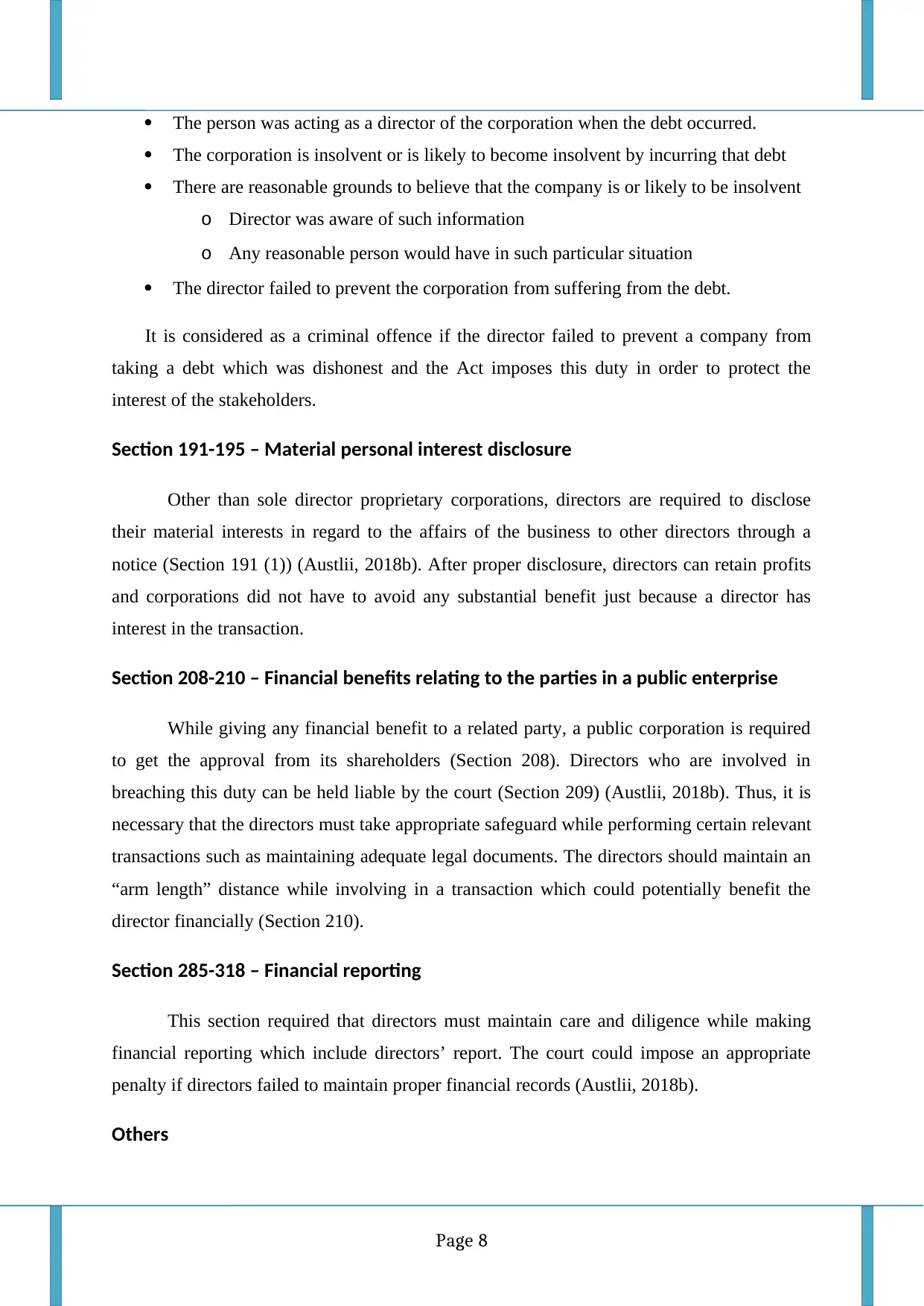
The person was acting as a director of the corporation when the debt occurred.
The corporation is insolvent or is likely to become insolvent by incurring that debt
There are reasonable grounds to believe that the company is or likely to be insolvent
o Director was aware of such information
o Any reasonable person would have in such particular situation
The director failed to prevent the corporation from suffering from the debt.
It is considered as a criminal offence if the director failed to prevent a company from
taking a debt which was dishonest and the Act imposes this duty in order to protect the
interest of the stakeholders.
Section 191-195 – Material personal interest disclosure
Other than sole director proprietary corporations, directors are required to disclose
their material interests in regard to the affairs of the business to other directors through a
notice (Section 191 (1)) (Austlii, 2018b). After proper disclosure, directors can retain profits
and corporations did not have to avoid any substantial benefit just because a director has
interest in the transaction.
Section 208-210 – Financial benefits relating to the parties in a public enterprise
While giving any financial benefit to a related party, a public corporation is required
to get the approval from its shareholders (Section 208). Directors who are involved in
breaching this duty can be held liable by the court (Section 209) (Austlii, 2018b). Thus, it is
necessary that the directors must take appropriate safeguard while performing certain relevant
transactions such as maintaining adequate legal documents. The directors should maintain an
“arm length” distance while involving in a transaction which could potentially benefit the
director financially (Section 210).
Section 285-318 – Financial reporting
This section required that directors must maintain care and diligence while making
financial reporting which include directors’ report. The court could impose an appropriate
penalty if directors failed to maintain proper financial records (Austlii, 2018b).
Others
Page 8
The corporation is insolvent or is likely to become insolvent by incurring that debt
There are reasonable grounds to believe that the company is or likely to be insolvent
o Director was aware of such information
o Any reasonable person would have in such particular situation
The director failed to prevent the corporation from suffering from the debt.
It is considered as a criminal offence if the director failed to prevent a company from
taking a debt which was dishonest and the Act imposes this duty in order to protect the
interest of the stakeholders.
Section 191-195 – Material personal interest disclosure
Other than sole director proprietary corporations, directors are required to disclose
their material interests in regard to the affairs of the business to other directors through a
notice (Section 191 (1)) (Austlii, 2018b). After proper disclosure, directors can retain profits
and corporations did not have to avoid any substantial benefit just because a director has
interest in the transaction.
Section 208-210 – Financial benefits relating to the parties in a public enterprise
While giving any financial benefit to a related party, a public corporation is required
to get the approval from its shareholders (Section 208). Directors who are involved in
breaching this duty can be held liable by the court (Section 209) (Austlii, 2018b). Thus, it is
necessary that the directors must take appropriate safeguard while performing certain relevant
transactions such as maintaining adequate legal documents. The directors should maintain an
“arm length” distance while involving in a transaction which could potentially benefit the
director financially (Section 210).
Section 285-318 – Financial reporting
This section required that directors must maintain care and diligence while making
financial reporting which include directors’ report. The court could impose an appropriate
penalty if directors failed to maintain proper financial records (Austlii, 2018b).
Others
Page 8
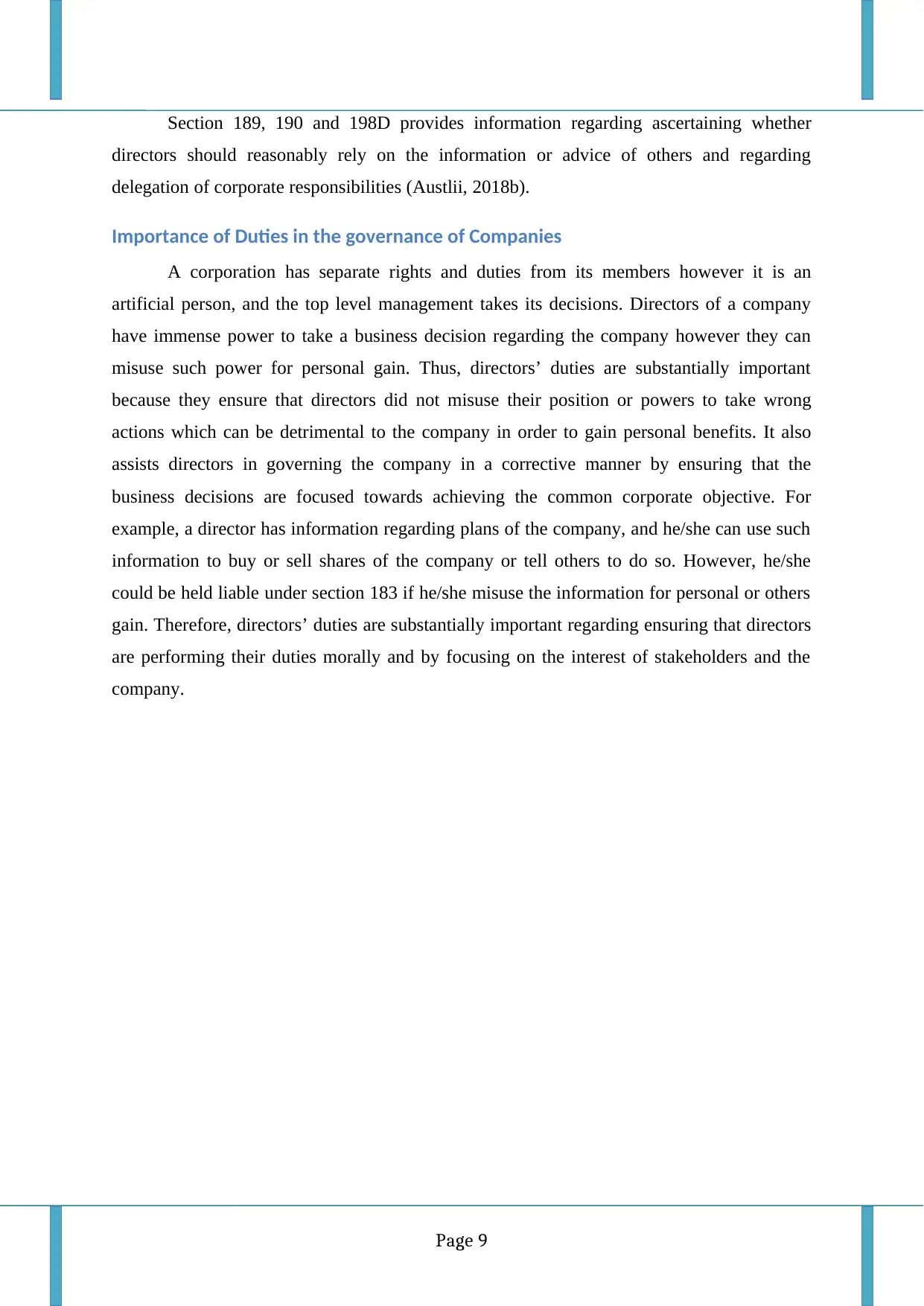
Section 189, 190 and 198D provides information regarding ascertaining whether
directors should reasonably rely on the information or advice of others and regarding
delegation of corporate responsibilities (Austlii, 2018b).
Importance of Duties in the governance of Companies
A corporation has separate rights and duties from its members however it is an
artificial person, and the top level management takes its decisions. Directors of a company
have immense power to take a business decision regarding the company however they can
misuse such power for personal gain. Thus, directors’ duties are substantially important
because they ensure that directors did not misuse their position or powers to take wrong
actions which can be detrimental to the company in order to gain personal benefits. It also
assists directors in governing the company in a corrective manner by ensuring that the
business decisions are focused towards achieving the common corporate objective. For
example, a director has information regarding plans of the company, and he/she can use such
information to buy or sell shares of the company or tell others to do so. However, he/she
could be held liable under section 183 if he/she misuse the information for personal or others
gain. Therefore, directors’ duties are substantially important regarding ensuring that directors
are performing their duties morally and by focusing on the interest of stakeholders and the
company.
Page 9
directors should reasonably rely on the information or advice of others and regarding
delegation of corporate responsibilities (Austlii, 2018b).
Importance of Duties in the governance of Companies
A corporation has separate rights and duties from its members however it is an
artificial person, and the top level management takes its decisions. Directors of a company
have immense power to take a business decision regarding the company however they can
misuse such power for personal gain. Thus, directors’ duties are substantially important
because they ensure that directors did not misuse their position or powers to take wrong
actions which can be detrimental to the company in order to gain personal benefits. It also
assists directors in governing the company in a corrective manner by ensuring that the
business decisions are focused towards achieving the common corporate objective. For
example, a director has information regarding plans of the company, and he/she can use such
information to buy or sell shares of the company or tell others to do so. However, he/she
could be held liable under section 183 if he/she misuse the information for personal or others
gain. Therefore, directors’ duties are substantially important regarding ensuring that directors
are performing their duties morally and by focusing on the interest of stakeholders and the
company.
Page 9
Secure Best Marks with AI Grader
Need help grading? Try our AI Grader for instant feedback on your assignments.
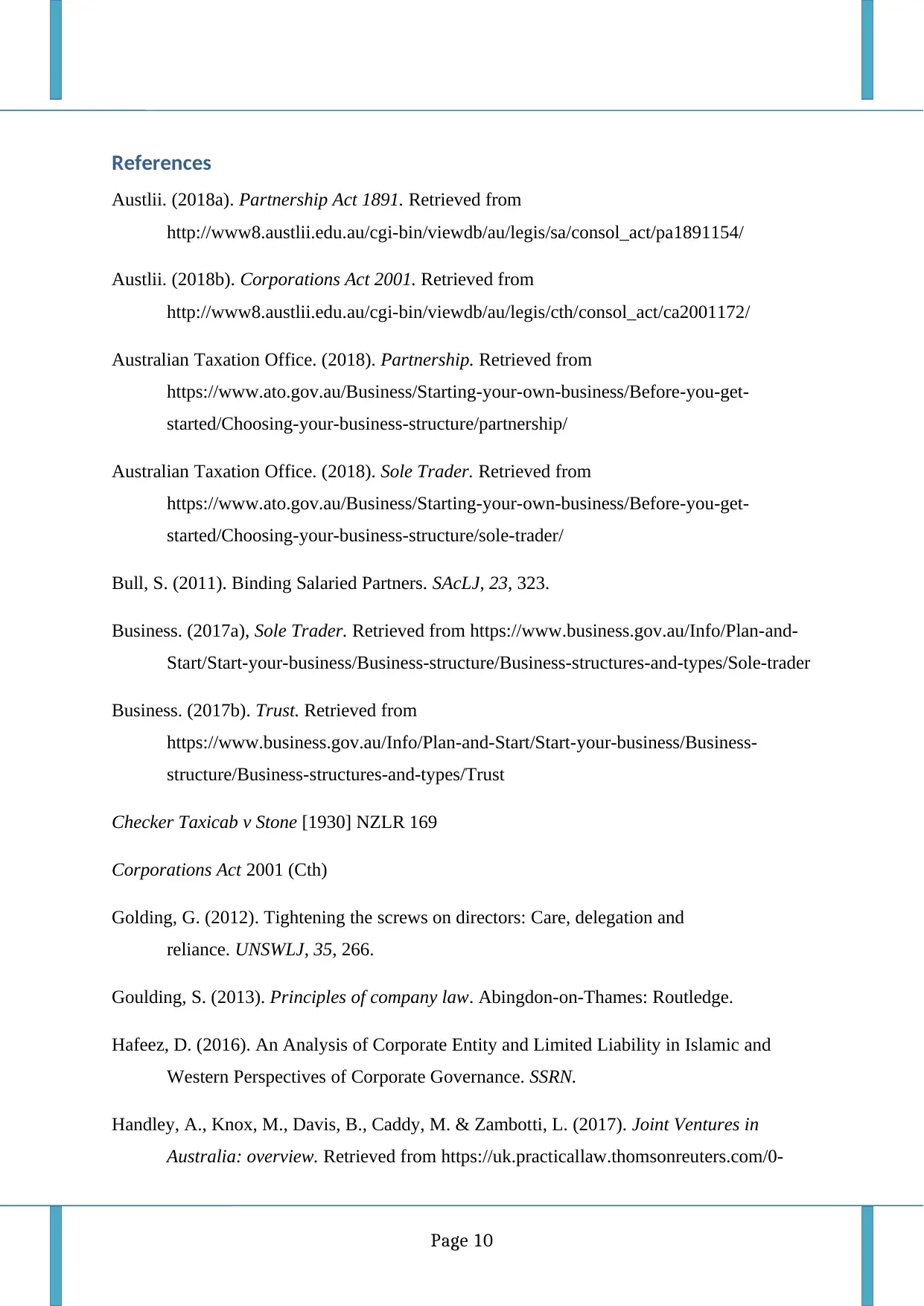
References
Austlii. (2018a). Partnership Act 1891. Retrieved from
http://www8.austlii.edu.au/cgi-bin/viewdb/au/legis/sa/consol_act/pa1891154/
Austlii. (2018b). Corporations Act 2001. Retrieved from
http://www8.austlii.edu.au/cgi-bin/viewdb/au/legis/cth/consol_act/ca2001172/
Australian Taxation Office. (2018). Partnership. Retrieved from
https://www.ato.gov.au/Business/Starting-your-own-business/Before-you-get-
started/Choosing-your-business-structure/partnership/
Australian Taxation Office. (2018). Sole Trader. Retrieved from
https://www.ato.gov.au/Business/Starting-your-own-business/Before-you-get-
started/Choosing-your-business-structure/sole-trader/
Bull, S. (2011). Binding Salaried Partners. SAcLJ, 23, 323.
Business. (2017a), Sole Trader. Retrieved from https://www.business.gov.au/Info/Plan-and-
Start/Start-your-business/Business-structure/Business-structures-and-types/Sole-trader
Business. (2017b). Trust. Retrieved from
https://www.business.gov.au/Info/Plan-and-Start/Start-your-business/Business-
structure/Business-structures-and-types/Trust
Checker Taxicab v Stone [1930] NZLR 169
Corporations Act 2001 (Cth)
Golding, G. (2012). Tightening the screws on directors: Care, delegation and
reliance. UNSWLJ, 35, 266.
Goulding, S. (2013). Principles of company law. Abingdon-on-Thames: Routledge.
Hafeez, D. (2016). An Analysis of Corporate Entity and Limited Liability in Islamic and
Western Perspectives of Corporate Governance. SSRN.
Handley, A., Knox, M., Davis, B., Caddy, M. & Zambotti, L. (2017). Joint Ventures in
Australia: overview. Retrieved from https://uk.practicallaw.thomsonreuters.com/0-
Page 10
Austlii. (2018a). Partnership Act 1891. Retrieved from
http://www8.austlii.edu.au/cgi-bin/viewdb/au/legis/sa/consol_act/pa1891154/
Austlii. (2018b). Corporations Act 2001. Retrieved from
http://www8.austlii.edu.au/cgi-bin/viewdb/au/legis/cth/consol_act/ca2001172/
Australian Taxation Office. (2018). Partnership. Retrieved from
https://www.ato.gov.au/Business/Starting-your-own-business/Before-you-get-
started/Choosing-your-business-structure/partnership/
Australian Taxation Office. (2018). Sole Trader. Retrieved from
https://www.ato.gov.au/Business/Starting-your-own-business/Before-you-get-
started/Choosing-your-business-structure/sole-trader/
Bull, S. (2011). Binding Salaried Partners. SAcLJ, 23, 323.
Business. (2017a), Sole Trader. Retrieved from https://www.business.gov.au/Info/Plan-and-
Start/Start-your-business/Business-structure/Business-structures-and-types/Sole-trader
Business. (2017b). Trust. Retrieved from
https://www.business.gov.au/Info/Plan-and-Start/Start-your-business/Business-
structure/Business-structures-and-types/Trust
Checker Taxicab v Stone [1930] NZLR 169
Corporations Act 2001 (Cth)
Golding, G. (2012). Tightening the screws on directors: Care, delegation and
reliance. UNSWLJ, 35, 266.
Goulding, S. (2013). Principles of company law. Abingdon-on-Thames: Routledge.
Hafeez, D. (2016). An Analysis of Corporate Entity and Limited Liability in Islamic and
Western Perspectives of Corporate Governance. SSRN.
Handley, A., Knox, M., Davis, B., Caddy, M. & Zambotti, L. (2017). Joint Ventures in
Australia: overview. Retrieved from https://uk.practicallaw.thomsonreuters.com/0-
Page 10
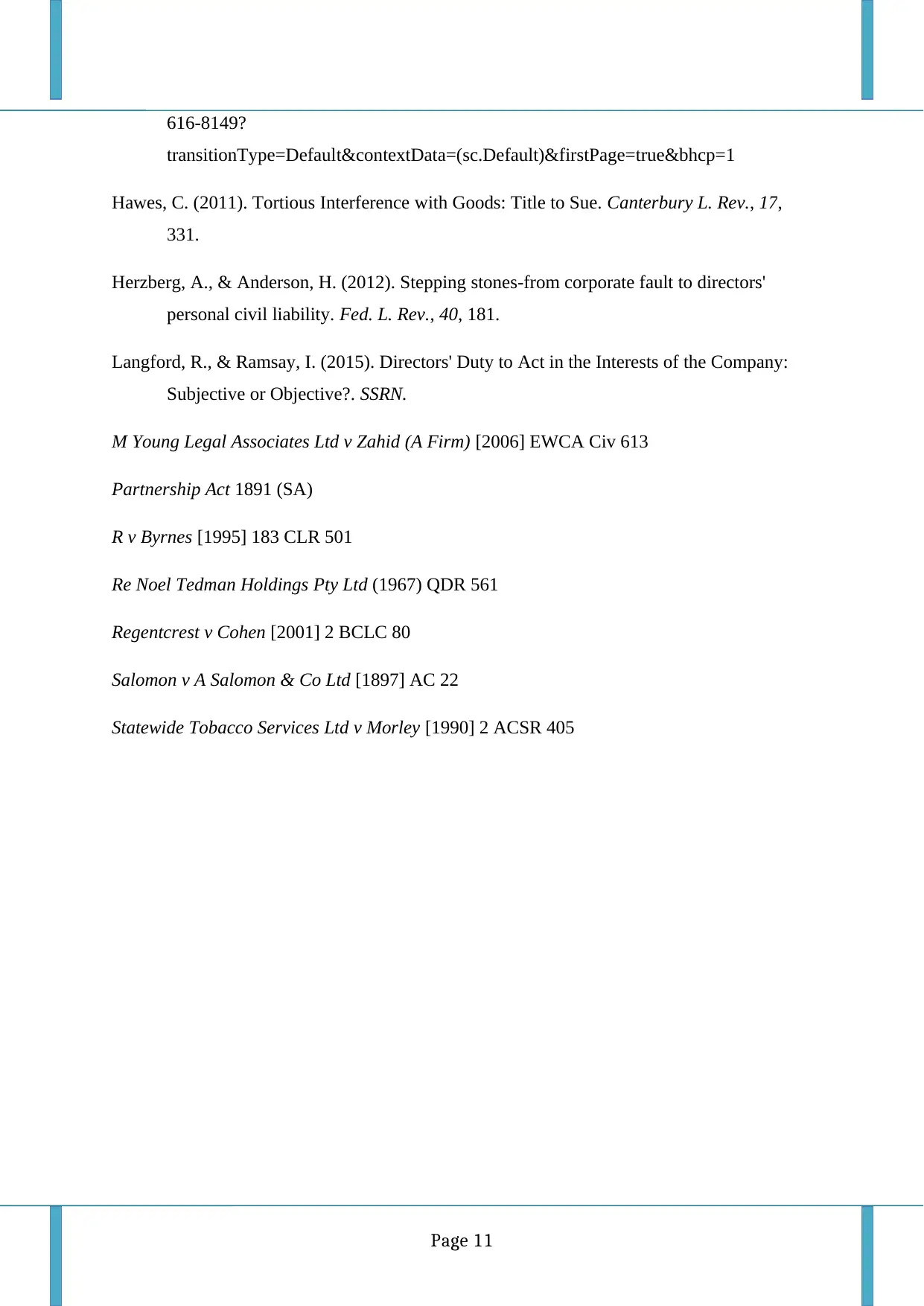
616-8149?
transitionType=Default&contextData=(sc.Default)&firstPage=true&bhcp=1
Hawes, C. (2011). Tortious Interference with Goods: Title to Sue. Canterbury L. Rev., 17,
331.
Herzberg, A., & Anderson, H. (2012). Stepping stones-from corporate fault to directors'
personal civil liability. Fed. L. Rev., 40, 181.
Langford, R., & Ramsay, I. (2015). Directors' Duty to Act in the Interests of the Company:
Subjective or Objective?. SSRN.
M Young Legal Associates Ltd v Zahid (A Firm) [2006] EWCA Civ 613
Partnership Act 1891 (SA)
R v Byrnes [1995] 183 CLR 501
Re Noel Tedman Holdings Pty Ltd (1967) QDR 561
Regentcrest v Cohen [2001] 2 BCLC 80
Salomon v A Salomon & Co Ltd [1897] AC 22
Statewide Tobacco Services Ltd v Morley [1990] 2 ACSR 405
Page 11
transitionType=Default&contextData=(sc.Default)&firstPage=true&bhcp=1
Hawes, C. (2011). Tortious Interference with Goods: Title to Sue. Canterbury L. Rev., 17,
331.
Herzberg, A., & Anderson, H. (2012). Stepping stones-from corporate fault to directors'
personal civil liability. Fed. L. Rev., 40, 181.
Langford, R., & Ramsay, I. (2015). Directors' Duty to Act in the Interests of the Company:
Subjective or Objective?. SSRN.
M Young Legal Associates Ltd v Zahid (A Firm) [2006] EWCA Civ 613
Partnership Act 1891 (SA)
R v Byrnes [1995] 183 CLR 501
Re Noel Tedman Holdings Pty Ltd (1967) QDR 561
Regentcrest v Cohen [2001] 2 BCLC 80
Salomon v A Salomon & Co Ltd [1897] AC 22
Statewide Tobacco Services Ltd v Morley [1990] 2 ACSR 405
Page 11
1 out of 12
Related Documents
Your All-in-One AI-Powered Toolkit for Academic Success.
+13062052269
info@desklib.com
Available 24*7 on WhatsApp / Email
![[object Object]](/_next/static/media/star-bottom.7253800d.svg)
Unlock your academic potential
© 2024 | Zucol Services PVT LTD | All rights reserved.




